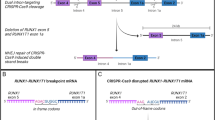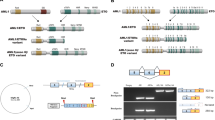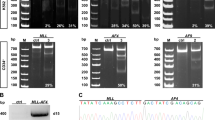Abstract
Translocation (12;21), the most frequent chromosomal aberration in childhood acute lymphoblastic leukemia, creates TEL/AML1 fusion gene. Resulting hybrid protein was shown to have a role in pre-leukemia establishment. To address its role for leukemic cell survival, we applied RNA interference to silence TEL/AML1 in leukemic cells. We designed and tested 11 different oligonucleotides targeting the TEL/AML1 fusion site. Using most efficient siRNAs, we achieved an average of 74–86% TEL/AML1 protein knockdown in REH and UOC-B6 leukemic cells, respectively. TEL/AML1 silencing neither decreased cell viability, nor induced apoptosis. On the contrary, it resulted in the modest but significant increase in the S phase fraction and in higher proliferation rate. Opposite effects on cell cycle distribution and proliferation were induced by AML1 silencing, thus, supporting our hypothesis that TEL/AML1 may block AML1-mediated promotion of G1/S progression through the cell cycle. In line with the lack of major effect on phenotype, we found no significant changes in clonogenic potential and global gene expression pattern upon TEL/AML1 depletion. Our data suggest that though TEL/AML1 is important for the (pre)leukemic clone development, it may be dispensable for leukemic cell survival and would not be a suitable target for gene-specific therapy.
This is a preview of subscription content, access via your institution
Access options






Similar content being viewed by others
References
Bohlander SK . ETV6: a versatile player in leukemogenesis. Semin Cancer Biol 2005; 15: 162–174.
Lutterbach B, Hiebert SW . Role of the transcription factor AML-1 in acute leukemia and hematopoietic differentiation. Gene 2000; 245: 223–235.
Romana SP, Poirel H, Leconiat M, Flexor MA, Mauchauffe M, Jonveaux P et al. High frequency of t(12;21) in childhood B-lineage acute lymphoblastic leukemia. Blood 1995; 86: 4263–4269.
Shurtleff SA, Buijs A, Behm FG, Rubnitz JE, Raimondi SC, Hancock ML et al. TEL/AML1 fusion resulting from a cryptic t(12;21) is the most common genetic lesion in pediatric ALL and defines a subgroup of patients with an excellent prognosis. Leukemia 1995; 9: 1985–1989.
Hiebert SW, Sun W, Davis JN, Golub T, Shurtleff S, Buijs A et al. The t(12;21) translocation converts AML-1B from an activator to a repressor of transcription. Mol Cell Biol 1996; 16: 1349–1355.
Morrow M, Samanta A, Kioussis D, Brady HJ, Williams O . TEL-AML1 preleukemic activity requires the DNA binding domain of AML1 and the dimerization and corepressor binding domains of TEL. Oncogene 2007; 26: 4404–4414.
Fears S, Gavin M, Zhang DE, Hetherington C, Ben-David Y, Rowley JD et al. Functional characterization of ETV6 and ETV6/CBFA2 in the regulation of the MCSFR proximal promoter. Proc Natl Acad Sci USA 1997; 94: 1949–1954.
Starkova J, Madzo J, Cario G, Kalina T, Ford A, Zaliova M et al. The identification of (ETV6)/RUNX1-regulated genes in lymphopoiesis using histone deacetylase inhibitors in ETV6/RUNX1-positive lymphoid leukemic cells. Clin Cancer Res 2007; 13: 1726–1735.
Uchida H, Downing JR, Miyazaki Y, Frank R, Zhang J, Nimer SD . Three distinct domains in TEL-AML1 are required for transcriptional repression of the IL-3 promoter. Oncogene 1999; 18: 1015–1022.
Andreasson P, Schwaller J, Anastasiadou E, Aster J, Gilliland DG . The expression of ETV6/CBFA2 (TEL/AML1) is not sufficient for the transformation of hematopoietic cell lines in vitro or the induction of hematologic disease in vivo. Cancer Genet Cytogenet 2001; 130: 93–104.
Fischer M, Schwieger M, Horn S, Niebuhr B, Ford A, Roscher S et al. Defining the oncogenic function of the TEL/AML1 (ETV6/RUNX1) fusion protein in a mouse model. Oncogene 2005; 24: 7579–7591.
Morrow M, Horton S, Kioussis D, Brady HJ, Williams O . TEL-AML1 promotes development of specific hematopoietic lineages consistent with preleukemic activity. Blood 2004; 103: 3890–3896.
Tsuzuki S, Seto M, Greaves M, Enver T . Modeling first-hit functions of the t(12;21) TEL-AML1 translocation in mice. Proc Natl Acad Sci USA 2004; 101: 8443–8448.
Kim DH, Moldwin RL, Vignon C, Bohlander SK, Suto Y, Giordano L et al. TEL-AML1 translocations with TEL and CDKN2 inactivation in acute lymphoblastic leukemia cell lines. Blood 1996; 88: 785–794.
Diakos C, Krapf G, Gerner C, Inthal A, Lemberger C, Ban J et al. RNAi-mediated silencing of TEL/AML1 reveals a heat-shock protein- and survivin-dependent mechanism for survival. Blood 2007; 109: 2607–2610.
Chomczynski P, Sacchi N . Single-step method of RNA isolation by acid guanidinium thiocyanate-phenol-chloroform extraction. Anal Biochem 1987; 162: 156–159.
Gabert J, Beillard E, van der Velden VH, Bi W, Grimwade D, Pallisgaard N et al. Standardization and quality control studies of ‘real-time’ quantitative reverse transcriptase polymerase chain reaction of fusion gene transcripts for residual disease detection in leukemia – a Europe Against Cancer program. Leukemia 2003; 17: 2318–2357.
Madzo J, Zuna J, Muzikova K, Kalinova M, Krejci O, Hrusak O et al. Slower molecular response to treatment predicts poor outcome in patients with TEL/AML1 positive acute lymphoblastic leukemia: prospective real-time quantitative reverse transcriptase-polymerase chain reaction study. Cancer 2003; 97: 105–113.
Abramoff MD, Magelhaes PJ, Ram SJ . Image Processing with ImageJ. Biophotonics International 2004; 11: 36–42.
Tusher VG, Tibshirani R, Chu G . Significance analysis of microarrays applied to the ionizing radiation response. Proc Natl Acad Sci USA 2001; 98: 5116–5121.
Lou J, Cao W, Bernardin F, Ayyanathan K, Rauscher IF, Friedman AD . Exogenous cdk4 overcomes reduced cdk4 RNA and inhibition of G1 progression in hematopoietic cells expressing a dominant-negative CBF - a model for overcoming inhibition of proliferation by CBF oncoproteins. Oncogene 2000; 19: 2695–2703.
Strom DK, Nip J, Westendorf JJ, Linggi B, Lutterbach B, Downing JR et al. Expression of the AML-1 oncogene shortens the G(1) phase of the cell cycle. J Biol Chem 2000; 275: 3438–3445.
Rangatia J, Bonnet D . Transient or long-term silencing of BCR-ABL alone induces cell cycle and proliferation arrest, apoptosis and differentiation. Leukemia 2006; 20: 68–76.
Thomas M, Gessner A, Vornlocher HP, Hadwiger P, Greil J, Heidenreich O . Targeting MLL-AF4 with short interfering RNAs inhibits clonogenicity and engraftment of t(4;11)-positive human leukemic cells. Blood 2005; 106: 3559–3566.
Wilda M, Fuchs U, Wossmann W, Borkhardt A . Killing of leukemic cells with a BCR/ABL fusion gene by RNA interference (RNAi). Oncogene 2002; 21: 5716–5724.
Ford AM, Bennett CA, Price CM, Bruin MC, Van Wering ER, Greaves M . Fetal origins of the TEL-AML1 fusion gene in identical twins with leukemia. Proc Natl Acad Sci USA 1998; 95: 4584–4588.
Greaves M . Pre-natal origins of childhood leukemia. Rev Clin Exp Hematol 2003; 7: 233–245.
Mori H, Colman SM, Xiao Z, Ford AM, Healy LE, Donaldson C et al. Chromosome translocations and covert leukemic clones are generated during normal fetal development. Proc Natl Acad Sci USA 2002; 99: 8242–8247.
Trka J, Zuna J, Hrusak O, Kalinova M, Muzikova K, Lauschman H et al. Impact of TEL/AML1-positive patients on age distribution of childhood acute lymphoblastic leukemia in Czech Republic. Pediatric Hematology Working Group in Czech Republic. Leukemia 1998; 12: 996–997.
Mullighan CG, Goorha S, Radtke I, Miller CB, Coustan-Smith E, Dalton JD et al. Genome-wide analysis of genetic alterations in acute lymphoblastic leukaemia. Nature 2007; 446: 758–764.
Bateman CM, Colman SM, Chaplin T, Young BD, Eden TO, Bhakta M et al. Acquisition of genome-wide copy number alterations in monozygotic twins with acute lymphoblastic leukemia. Blood 2010; 115: 3553–3558.
Gefen N, Binder V, Zaliova M, Linka Y, Morrow M, Novosel A et al. Hsa-mir-125b-2 is highly expressed in childhood ETV6/RUNX1 (TEL/AML1) leukemias and confers survival advantage to growth inhibitory signals independent of p53. Leukemia 2010; 24: 89–96.
Schindler JW, Van Buren D, Foudi A, Krejci O, Qin J, Orkin SH et al. TEL-AML1 corrupts hematopoietic stem cells to persist in the bone marrow and initiate leukemia. Cell Stem Cell 2009; 5: 43–53.
Ford AM, Palmi C, Bueno C, Hong D, Cardus P, Knight D et al. The TEL-AML1 leukemia fusion gene dysregulates the TGF-beta pathway in early B lineage progenitor cells. J Clin Invest 2009; 119: 826–836.
Burel SA, Harakawa N, Zhou L, Pabst T, Tenen DG, Zhang DE . Dichotomy of AML1-ETO functions: growth arrest versus block of differentiation. Mol Cell Biol 2001; 21: 5577–5590.
Libermann TA, Pan Z, Akbarali Y, Hetherington CJ, Boltax J, Yergeau DA et al. AML1 (CBFalpha2) cooperates with B cell-specific activating protein (BSAP/PAX5) in activation of the B cell-specific BLK gene promoter. J Biol Chem 1999; 274: 24671–24676.
Pardali E, Xie XQ, Tsapogas P, Itoh S, Arvanitidis K, Heldin CH et al. Smad and AML proteins synergistically confer transforming growth factor beta1 responsiveness to human germ-line IgA genes. J Biol Chem 2000; 275: 3552–3560.
Acknowledgements
This work was supported by grants MSM0021620813 and MZ0FNM2005.
Author information
Authors and Affiliations
Corresponding author
Ethics declarations
Competing interests
The authors declare no conflicts of interests.
Additional information
Supplementary Information accompanies the paper on the Leukemia website
Rights and permissions
About this article
Cite this article
Zaliova, M., Madzo, J., Cario, G. et al. Revealing the role of TEL/AML1 for leukemic cell survival by RNAi-mediated silencing. Leukemia 25, 313–320 (2011). https://doi.org/10.1038/leu.2010.277
Received:
Revised:
Accepted:
Published:
Issue Date:
DOI: https://doi.org/10.1038/leu.2010.277
Keywords
This article is cited by
-
RNA binding protein IGF2BP1 synergizes with ETV6-RUNX1 to drive oncogenic signaling in B-cell Acute Lymphoblastic Leukemia
Journal of Experimental & Clinical Cancer Research (2023)
-
Effects of p38α/β inhibition on acute lymphoblastic leukemia proliferation and survival in vivo
Leukemia (2015)
-
Targeting the PI3K/Akt/mTOR signaling pathway in B-precursor acute lymphoblastic leukemia and its therapeutic potential
Leukemia (2014)



